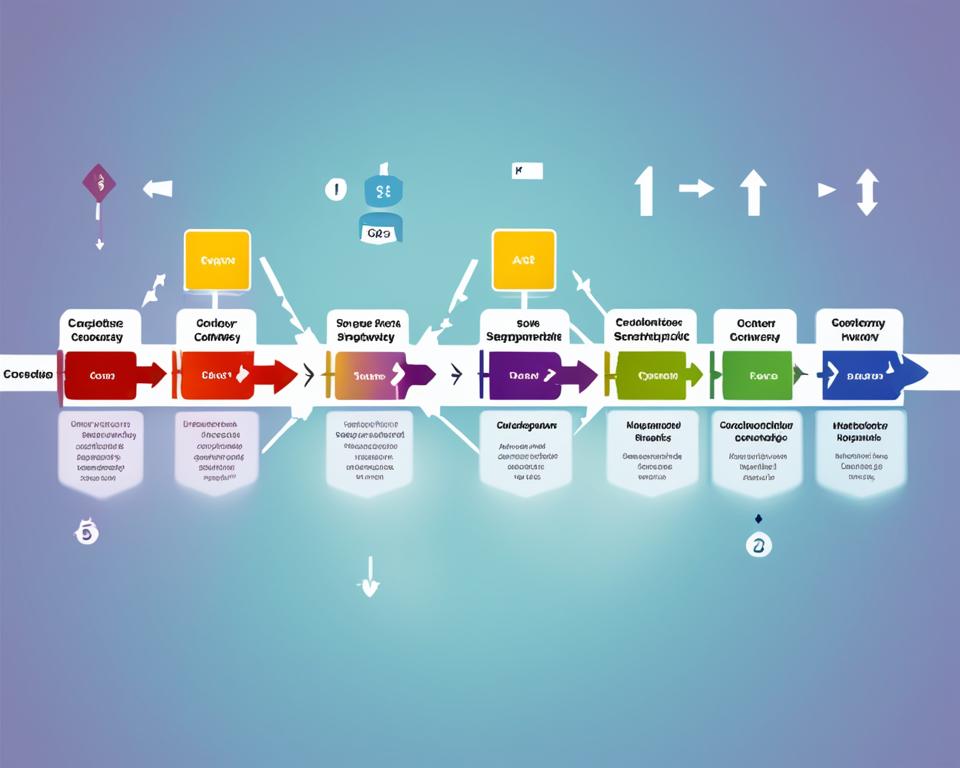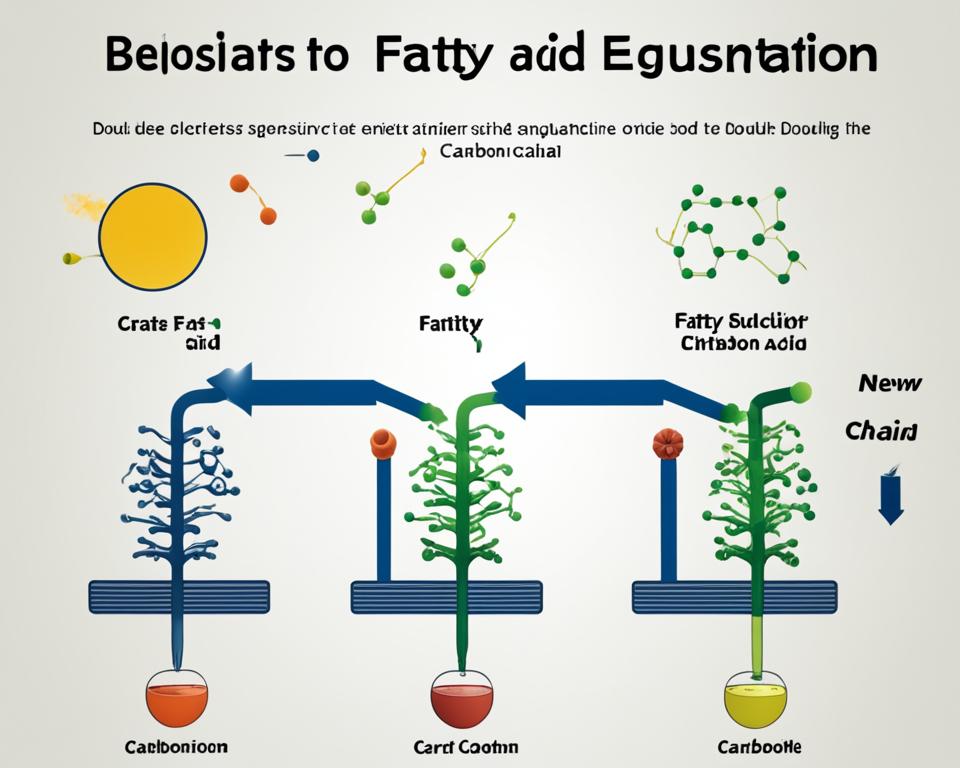
Have you ever wondered how our bodies turn simple molecules into cell membrane builders and energy stores? This process is called fatty acid synthesis. It’s a key pathway that interests scientists and health experts. What are the essential steps to understanding this process? Let’s dive into the secrets behind lipid metabolism.
Fatty acid synthesis grows lipids from easy-to-find materials like acetyl-CoA and malonyl-CoA.1 It happens in the cell’s cytoplasm and endoplasmic reticulum. This method is somewhat like beta-oxidation but has its own differences.2
The process starts with moving acetyl-CoA from the mitochondria to the cytoplasm. This is done using a citrate shuttle or acetylcarnitine carrier.2 Then, in the cytoplasm, acetyl-CoA turns into malonyl-CoA with the help of acetyl-CoA carboxylase (ACC). This change is the main step in the whole fatty acid synthesis.2
Both acetyl-CoA and malonyl-CoA are attached to the acyl carrier protein (ACP). This creates acetyl-ACP and malonyl-ACP.2 Following this, a series of reactions occur. Each step adds two-carbon pieces from malonyl-ACP to the fatty acid chain. These reactions continue until a 16-carbon palmitate molecule is made.1
Key Takeaways
- Fatty acid synthesis transforms simple materials into essential lipids.
- It takes place in the cytoplasm and endoplasmic reticulum, involving specific steps like moving acetyl-CoA.
- Acetyl-CoA carboxylase (ACC) is vital, converting acetyl-CoA into malonyl-CoA.
- Consecutive reactions add pieces to the fatty acid chain, forming a palmitate molecule.
- This molecule can grow longer and change in certain ways.
Introduction to Fatty Acid Synthesis
Fatty acid synthesis is a key process in our bodies. It makes fatty acids, important for storing energy and making cell structures. This happens in the cytoplasm and endoplasmic reticulum. We use simple building blocks like acetyl-CoA and malonyl-CoA to create these important substances.2
The process is like beta-oxidation. But there are differences in how it prepares, the enzymes used, and the shape of the molecules. Knowing how fatty acids are made helps us understand our health and diseases better.
The first step in making fatty acids is moving acetyl-CoA from the mitochondria to the cytoplasm. We do this with the citrate shuttle or the acetylcarnitine carrier.2 Then, in the cytoplasm, acetyl-CoA changes into malonyl-CoA.
This change is controlled and sets the pace for fatty acid creation.2 Both acetyl-CoA and malonyl-CoA are attached to a protein called acyl carrier protein (ACP). This creates acetyl-ACP and malonyl-ACP. These compounds help add two-carbon pieces to the fatty acid chain, creating a full 16-carbon molecule called palmitate.2
The process of making fatty acids has many steps and happens mainly in the cytoplasm and endoplasmic reticulum.2 Knowing about these steps, enzymes, and how they are controlled is vital. It helps us grasp how our bodies handle fats. This includes how we store energy, make cell structures, and signal between cells.
Fatty Acid Synthesis: The Process
Acetyl-CoA: The Starting Point
The journey of making fatty acids starts in the mitochondria. Acetyl-CoA is carried to the cytoplasm, the cell’s outer area. This happens through either the citrate shuttle or acetylcarnitine carrier.2 In the cytoplasm, an enzyme changes acetyl-CoA to malonyl-CoA. This enzyme is called acetyl-CoA carboxylase (ACC), and it is a crucial step.23
Maloney-CoA: The Building Block
Malonyl-CoA is important in making fatty acids. It provides two-carbon pieces that attach to the fatty acid chain. Turning acetyl-CoA into malonyl-CoA is critical for creating saturated fats.3
Condensation: Carbon Chain Grows
Fatty acid synthesis is a series of key steps. This includes adding malonyl-CoA to an expanding fatty acid chain. This happens via a Claisen condensation reaction.2 It stops when a 16-carbon palmitoyl-CoA is made.2

Enzymes Involved in Fatty Acid Synthesis
The main enzymes used for making fatty acids are acetyl-CoA carboxylase (ACC) and the fatty acid synthase (FAS) complex.2
Acetyl-CoA Carboxylase (ACC)
Acetyl-CoA carboxylase (ACC) changes acetyl-CoA to malonyl-CoA. This step is key in controlling the fatty acid making process.2 ACC’s activity is regulated by signals from the cell. For example, if it is turned on by AMP Kinase and Protein Kinase A. Insulin can turn it off.
ACC is also stopped using palmitoyl-CoA, a fatty acid. This shows how cells carefully manage fatty acid production.2
Fatty Acid Synthase (FAS) Complex
In animals, making fatty acids requires a group of enzymes to work together. This group is called the Fatty Acid Synthase (FAS) complex.2 It carries out several steps, adding two-carbon pieces to the fatty acid chain. This goes on until a 16-carbon fatty acid (palmitic acid) is made.3
Fatty Acid Synthesis Location
Fatty acid synthesis mainly happens in the cytoplasm32 and endoplasmic reticulum2. It starts with moving acetyl-CoA from the mitochondria to the cytoplasm. Then, it turns into malonyl-CoA in the cytoplasm.2 After that, the fatty acid chain gets longer with the help of the fatty acid synthase (FAS) complex, all in the cytoplasm.3
Both citrate and acetylcarnitine help transport acetyl-CoA. This process happens in the cytoplasm2. There, acetyl-CoA changes to malonyl-CoA. This change is done by acetyl-CoA carboxylase, an important enzyme in fatty acid synthesis2.
Fatty acids longer than 16 carbons grow more in the endoplasmic reticulum. They are elongated by specific enzymes called elongases2. The endoplasmic reticulum is also where the process of desaturation occurs. This is done by enzymes called desaturases2.
Elongation and Desaturation of Fatty Acids
Fatty acids can get longer and change with a process called elongation and desaturation. This happens in the cell’s endoplasmic reticulum. To get longer, fatty acids add two-carbon units. This is done using elongase enzymes. This is different from how they were first made.4
Elongation of the Endoplasmic Reticulum
A important way fatty acids get longer involves several enzymes and specific molecules. The process uses substances like malonyl-CoA and NADPH. It helps make fatty acids longer, especially those with 12 or more carbon atoms.5 Scientists have found special enzymes, called Elovl enzymes, in the genes of mice, rats, and humans. These enzymes are key to making very long chain fatty acids longer.5
There are two types of Elovl enzymes, each working on different fatty acids. One type, including Elovl-1 and Elovl-3, works on fats that are saturated or monounsaturated. The other type, like Elovl-2 and Elovl-4, lengthen polyunsaturated fats.5 The liver of rats and mice have five of these enzymes. Together with fatty acid desaturases, they help make long, healthy fats for cells.
Desaturation by Desaturases
Another important step is desaturation. Enzymes called desaturases do this. They are found in almost all cells. They can make cis-double bonds in fats.4 A type of desaturase, the Stearoyl-Coenzyme A desaturase (SCD), is found in the liver and fat tissues. It works on many fats, even trans-fatty acids. Only marine algae produce a lot of a special healthy fat called docosahexaenoic acid (DHA).4
In certain active white blood cells, the ability to change fats is very high. These cells can work with special long-chain fats better than other cells. They can also create more double bonds in fats. This is because certain proteins become more active in these cells, helping them change fats. If a specific protein, ELOVL5, is not working well, these cells cannot make certain healthy fats anymore.6

Regulation of Fatty Acid Synthesis
The most critical point in making fatty acids slow down with acetyl-CoA is crucial.2 The key enzyme is acetyl-CoA carboxylase (ACC), which does this job well. It faces control from both what we call allosteric and also covalent regulation.
Allosteric control means the ACC gets a boost from citrate. This makes it more eager to work with Acetyl-CoA. But the long-chain fatty acyl-CoAs pull back on its enthusiasm. This helps slow down fatty acid making when we already have enough.2
Then, there’s covalent control. ACC can be switched off by being phosphorylated by some kinases like AMP-activated protein kinase (AMPK). This slowdown happens when the cell needs less fat made. On the other hand, certain other kinases, like those turned on by insulin, can set ACC in the mood to make more fatty acids.21
The combination of allosteric and covalent rules means our cells finely manage when to make or not make fats. They do this in tune with the cell’s energy levels, what food elements are around, and the signals sent by hormones like insulin and glucagon.21

fatty acid synthesis
Substrates and Cofactors
In fatty acid synthesis, the main players are acetyl-CoA, malonyl-CoA, and NADPH.3 Acetyl-CoA started the process. Malonyl-CoA brings in 2-carbon units for the fatty acid to grow.3 NADPH helps by giving energy and electrons. It’s needed for several reactions like condensation and reduction during synthesis.3
Citrate Shuttle and ATP Citrate Lease
Acetyl-CoA moves from the mitochondria to the cytoplasm using the citrate shuttle or acetylcarnitine carrier.2 In the cytoplasm, it becomes malonyl-CoA. This change is thanks to an enzyme called acetyl-CoA carboxylase (ACC). It’s an important step in fatty acid synthesis.2 ACC is activated by citrate but stopped by palmitoyl-CoA.2
ATP citrate lyase (ACL) also plays a big role in fatty acid synthesis. It turns citrate into acetyl-CoA.2 This starts the fatty acid synthesis process.2

Comparing Fatty Acid Synthesis and Beta-Oxidation
Fatty acid synthesis and beta-oxidation are related but not opposite. They differ in where they happen, their goals, enzymes used, and how they use energy.7
Beta-oxidation breaks down fatty acids in a cell’s mitochondria. Fatty acid synthesis puts them in the cytoplasm. One is a building process, the other breaking down.7 Degradation has enzymes for each step, but synthesis uses one complex.7
In beta-oxidation, NAD+ and FAD help take in electrons. NADPH gives electron synthesis.7 Breaking down fats makes ATP through acetyl-CoA, whereas making fats uses ATP.7
Both pathways use acetyl-CoA. It’s made in degradation and used first in synthesis. They both adjust to the cell’s energy needs.7
| Characteristics | Fatty Acid Synthesis | Beta-Oxidation |
|---|---|---|
| Cellular Location | Cytoplasm7 | Mitochondrial Matrix7 |
| Directionality | Constructive Process7 | Breakdown Process7 |
| Enzyme Complexes | Single Multi-Enzyme Complex7 | Separate Enzymes for Each Reaction7 |
| Co-factor Requirements | NADPH as Electron Donor7 | NAD+ and FAD as Electron Acceptors7 |
| Energy Production/Consumption | Consumes ATP7 | Generate ATP via Acetyl-CoA7 |
| Substrate | Acetyl-CoA and Malonyl-CoA7 | Acetyl-CoA7 |
Fatty acid synthesis and beta-oxidation have similarities like acetyl-CoA use. But they vary greatly in process details and effects. Knowing these differences helps understand lipid metabolism’s role in health and disease.78
Significance of Fatty Acid Synthesis
Fatty acid synthesis is crucial for the cell. It supports energy storage, builds membrane structure, and helps with cell signaling.9
Energy Storage
One main task of fatty acid synthesis is making long-chain fatty acids. For example, it creates palmitate. These fats can be saved as triglycerides in fat cells. This action is key for staying alive when no food is available.1
Membrane Structure
Newly made fatty acids are also put into phospholipids. These are essential for the cell’s walls. These fatty acids help keep the cell’s boundaries strong and flexible.9
Cell Signaling
Fatty acids and their forms do more than store energy. They also act as signals in the cell. They help control genes, fight inflammation, and manage how the body uses insulin.9
Fatty acid synthesis is vital. It keeps the cell’s life stable, manages energy, and promotes the health of the whole organism.1019
Conclusion
In conclusion, creating fats from simple substances is a crucial and complex job in our bodies.1 It mostly happens in the cytoplasm. The process uses special enzymes to turn small pieces into bigger fatty acids, such as acetyl-CoA and malonyl-CoA.1 This is key for storing energy, building cell walls, and sending messages in cells.
Controlling this making of fats is very important and happens in careful steps.1 Strangely, cancer cells make more fats by themselves. They increase their making process, which seems to help the growth of cancer.11 So, understanding how fats are made could be big for new cancer treatments.11
The data linked here12 shows more and more people are studying fat-making over time.12 This means we’re learning a lot about how this process works. And knowing this could lead to new things in drug making, technology, and farming.12
FAQ
What is the starting point for fatty acid synthesis?
The process starts with acetyl-CoA. It moves from mitochondria to cytoplasm with a citrate shuttle or acetyl-carnitine carrier.
What is the role of acetyl-CoA carboxylase (ACC) in fatty acid synthesis?
ACC turns acetyl-CoA into malonyl-CoA. This is crucial for making new fatty acids as it’s the starting point.
Where does the fatty acid synthesis pathway occur in the cell?
Fatty acid creation happens in the cytoplasm and endoplasmic reticulum. First, acetyl-CoA changes to malonyl-CoA in the cytoplasm. Then, fatty acid chains grow in the cytoplasm too with the help of FAS.
How are the fatty acids synthesized further elongated and desaturated?
In the endoplasmic reticulum, fatty acids get longer and gain double bonds. For lengthening, they keep adding two-carbon units with the help of other enzymes. Adding double bonds requires desaturase enzymes.
What are the key substrates and cofactors for fatty acid synthesis?
Acetyl-CoA and malonyl-CoA are vital. NADPH and ATP are also needed. The citrate shuttle and ATP citrate lease help provide what’s necessary.
How does fatty acid synthesis differ from beta-oxidation?
Fatty acid making and breaking them down are different processes. They use different preparations and enzymes. Even the shape of the molecules involved is not the same.
What are the main functions of fatty acid synthesis?
Fatty acid synthesis is key for storing energy, making cell membranes, and cell signaling. It’s essential for the cell’s life processes.
Source Links
- https://www.sciencedirect.com/topics/medicine-and-dentistry/fatty-acid-synthesis
- https://bio.libretexts.org/Bookshelves/Biochemistry/Book:_Biochemistry_Free_and_Easy_(Ahern_and_Rajagopal)/06:_Metabolism_I_-_Oxidative_Reductive_Processes/6.12:_Fatty_Acid_Synthesis
- https://en.wikipedia.org/wiki/Fatty_acid_synthesis
- https://agrilife.org/animalscience/files/2012/04/Handout-6-Fatty-Acid-Elongation-and-Desaturation.pdf
- https://www.ncbi.nlm.nih.gov/pmc/articles/PMC2764369/
- https://www.ncbi.nlm.nih.gov/pmc/articles/PMC6277159/
- https://www.vaia.com/en-us/textbooks/biology/biochemistry-1-edition/chapter-16/problem-6-compare-and-contrast-the-fatty-acid-degradation-an/
- https://mcb.berkeley.edu/labs/krantz/mcb102/lect_S2008/MCB102-SPRING2008-LECTURE13-FATTY_ACID_BIOSYNTHESIS.pdf
- https://byjus.com/neet/fatty-acid-biosynthesis/
- https://www.ncbi.nlm.nih.gov/pmc/articles/PMC6258005/
- https://www.nature.com/articles/6605007
- https://www.ncbi.nlm.nih.gov/pmc/articles/PMC4276719/






